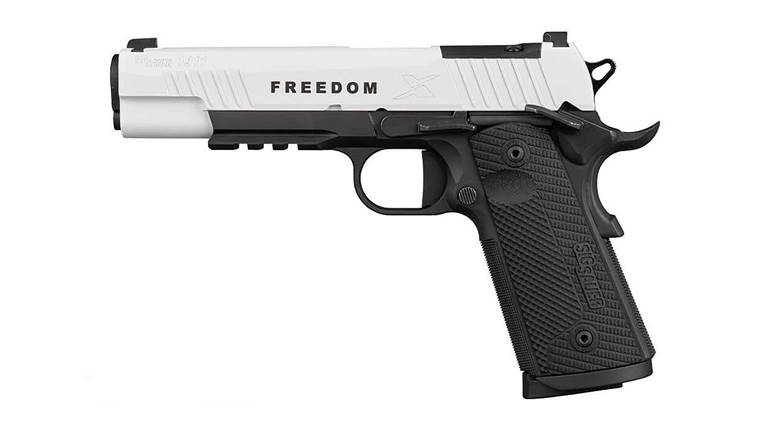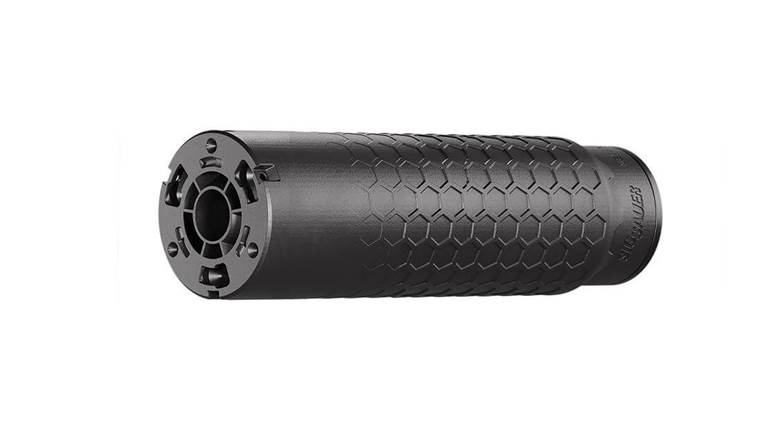
A significant number of American shooters consider SIG Sauer to be primarily a handgun manufacturer. This is in direct contradiction to the fact that the company’s roots in Europe are tied to some extremely prolific and respected military and law enforcement rifle designs. SIG Sauer has been making bold moves in the past few years to remedy this misconception. In particular, the company’s SIG556 series of 5.56x45 mm NATO rifles, which combine elements of the Swiss SIG SG 550 rifle with the AR-15, offered U.S. shooters a chance to own a rifle patterned much like the revered original Swiss design. In addition, the company also offers a line of highly regarded, long-range precision rifles based on proven Blaser and Sauer designs, further enhancing the company’s credentials as a top-tier rifle manufacturer.
The overall thrust of the offerings from the company, however, was arguably still somewhat Eurocentric. It was obvious SIG Sauer made an intelligent move to build on the strengths the international company could bring to bear through its subsidiaries. But, there proved to be a latent interest in tapping into a design more firmly rooted here in the United States: the AR-15 series of rifles.
A desire to cater more directly to the AR-15 market actually makes a great deal of sense considering the nature of SIG Sauer. The company’s practices present an unusual case study of modern business. While many companies in this country are actively outsourcing work to the rest of the world, SIG Sauer is actually bringing it into the country.
During the past four years, the SIG Sauer facility in Exeter, N.H., has grown by leaps and bounds, adding employees, machinery and manufacturing space. And this growth has gone hand-in-hand with the company’s expansion beyond its traditional niche with handguns and into rifles.
A large part of SIG Sauer’s business revolves around military and law enforcement contracts for its successful handgun designs. Nonetheless, the company recognized a strong desire for package deals with many of these customers. Often, when agencies contracted with SIG Sauer for handguns, they also showed interest in buying rifles.
“We have been very successful with the SIG556 platform in this respect,” SIG Sauer President and Chief Executive Officer Ron Cohen said recently. “However, we recognized that the AR-15/M16 family of rifles was clearly the dominant design around the world.” Many law enforcement agencies have a lengthy background with the AR design, Cohen explained, and SIG Sauer recognized that there was a strong interest for an improved version of the platform. The answer is the new semi-automatic SIG516 series of .223 Rem./5.56x45 mm NATO rifles.
A Better Mousetrap?
“The SIG516 not only gave us a chance to tap into this broad market, but it also offered SIG Sauer a chance to bring its own unique approach to firearm design and manufacture to this popular platform,” Cohen said. “It allowed us to take an established design and make it more robust and hardy while improving on its weak points.”
So what exactly does the new SIG516 series bring to the table? Despite the AR’s broad-based acceptance and its many positive attributes, the company recognized that the basic platform could use some attention in regards to its reliability in harsh environments. Although the standard AR can be a pleasure to shoot because of its excellent ergonomics and extremely good accuracy, its direct-impingement gas system is a point of contention for many. As a result, the SIG516 dispenses with the direct-impingement system and incorporates a proprietary gas-piston operating system designed to offer sound, reliable operation in even the most severe environments.
Shortly before my arrival in New Hampshire, SIG Sauer’s defense program manager, Robert Hirt, ran one of the 14½"-barreled prototypes through a 20,000-round torture test. The rifle ran without cleaning and only periodic oiling, and there was only a single failure to feed. Hirt and I fired the rifle at the SIG Sauer Academy ranges with a variety of 5.56x45 mm NATO/.223 Rem. ammunition ranging from light to heavyweight loadings, including frangible ammunition. A 30-round magazine was loaded with a mixture of all these, and then Hirt ripped off a 30-round shot string without a single malfunction.
To further demonstrate the rifle’s reliability, the same rifle was run through environmental torture tests. It was loaded and placed on “safe” and then dragged through sand. After the gun was inundated with sand, and after ensuring the bore was clear, Hirt once again loaded and fired a full magazine without a single hiccup. The final test was the most impressive—and don’t try this at home. A shallow trench was dug and the rifle buried in a bath of mud with the consistency ofwet concrete. After remaining there for a minute or so, Hirt pulled out the rifle and, after checking for bore obstructions, chambered a round and fired until the rifle ran dry. Once again, not a single malfunction.
Driving Change
Once the rifle was cleaned in a barrel of water, we headed back to the company’s headquarters to take a close, detailed look at the test rifle as well as a 16"-barreled SIG516 Patrol version. “Although the SIG516 brings a lot of improvements to the table, the gas-piston system is the most significant of them,” Hirt told me. He explained in detail how a standard direct-impingement system drives not only carbon and fouling into the action, but also excessive heat; the result is a system in which oil quickly evaporates, and lubrication is necessary to keep an AR running reliably.
The SIG516’s push-rod gas system is designed to reduce this effect by isolating heat and fouling forward of the action and above the barrel, keeping the critical action and chamber area of the rifle clean and cool. In addition, any excess gas in the self-cleaning system is vented out and downward in the forward portion of the handguard just to the rear of the rifle’s gas block through two vent holes in the piston rod.
The SIG516 features a three-position gas regulator located within the Picatinny rail-topped gas block. Sporting a round, grooved knob, the regulator has three markings: a small white dot, a larger white dot and a small red dot. The regulator is locked into position by a spring-loaded plunger on the forward face of the gas block and can be adjusted without tools. A prominent white line on the upper right side of the block aligns with the dots and offers a visual cue to the gas system’s setting.
The small white dot setting is for “standard” or normal operation, allowing enough gas to be tapped from the bore through the gas block to operate the rifle under normal conditions. The larger white dot setting is for “adverse” conditions and allows more gas through the system. The red dot setting is designed for use with a suppressor and minimizes the amount of gas allowed through the gas block.
The SIG516 will also be available with an optional fourth setting designed to completely cut off the gas system, making the rifle, in effect, a single-shot requiring manual cycling.
The gas system can be disassembled without requiring a full breakdown of the rifle. To remove the gas piston rod, the gas regulator must be unscrewed and removed from the front of the gas block. It does not employ an interrupted thread system, so it must be fully unscrewed. The steel gas piston rod is a one piece unit with a matte-gray, corrosion-resistant coating. It features a return spring assembly and dual gas vents on its forward portion.
The rear of the gas piston is designed to impact directly against the bolt carrier assembly, so the SIG516’s bolt carrier features an integral strike plate in place of a traditional gas key. This is the portion of the bolt carrier against which the rear of the piston impacts. The rear of the carrier has raised radial ridges designed to reduce friction between the carrier and lower receiver extension. Additionally, it provides greater reliability under adverse conditions because dirt, dust and sand can enter and not increase friction as with a perfectly concentric carrier. The bolt dispenses with the gas rings of a traditional AR system. The SIG516 does, however, feature an AR buffer system, and the buffer tube is designed to military rather than commercial specs.
Close Up
In its general configuration, the SIG516 Patrol is a flat-top AR carbine with a 16" barrel. The 7075-T6 forged aluminum A3-style flat-top upper receiver features the traditional forward assist and shell deflector, and it mates directly with the top rail of the carbine’s free-floated, four-rail fore-end as well as a strip of Picatinny rail on the top of the gas block. This provides users an uninterrupted strip of Picatinny rail along the entire upper length of the carbine.
The fore-end is an aluminum, SIG Sauer-branded Troy Industries MRF BattleRail unit free-floated around the barrel. The chrome-lined barrel, sporting the now seemingly standard M4-style contour, is fitted with a Yankee Hill Machine Co. Phantom flash suppressor.
The lower receiver, also of forged 7075-T6, sports unique cosmetic and ergonomic enhancements. The fence around the magazine release button on the right side of the lower is more pronounced than that of a standard AR, and the front face of the magazine well is checkered for enhanced purchase by the support hand. The left side of the lower receiver has a channel forward of the bolt catch to help prevent marring of the receiver during disassembly, and the mouth of the magazine well features a generous chamfer.
Further enhancements include a Magpul MIAD modular pistol grip and a Lewis Machine & Tool SOPMOD enhanced six-position buttstock. The pistol grip is customizable to a variety of hand sizes, and the buttstock sports a padded buttplate and enlarged cheek-weld sections that double as watertight battery storage compartments.
Hands On
Shortly after my visit to Exeter, my test SIG516 Patrol arrived. Once I had the rifle, I gave it a quick once-over, cleaning and lube, mounted a Leupold Mark 4 CQ/T optic and headed to the range with a sampling of .223 Rem. and 5.56x45 mm NATO ammunition.
I tested it for functioning and accuracy with three types of ammunition. The Patrol proved to be extremely pleasant to shoot, with a gentle recoil impulse. The two-stage trigger was excellent, breaking cleanly at 3 lbs. and making the SIG516 Patrol quite easy to shoot well. And shoot well it did, averaging roughly 1½" at 100 yds. overall with all three ammunition types and some Black Hills groups measuring less than 1 m.o.a. In addition, during the course of the few hundred rounds fired, I did not have a single malfunction with the carbine.
Once all was said and done, the SIG516 struck me as being exactly what SIG Sauer had intended: an enhanced AR that addresses the design’s perceived weak points while retaining all of its positive characteristics. The rifle was a pleasure to shoot, was accurate and appears to be undeniably reliable.
And, this is not the only offering planned for the series. In addition to more SIG516 5.56x45 mm NATO offerings, there are plans to introduce a variant in 7.62x51 mm NATO as well.
In my opinion, the SIG516 and its subsequent siblings portend great things for the future of the long-lived AR-style rifle, combining American know-how with precision European engineering—all in a tough and reliable package.





































